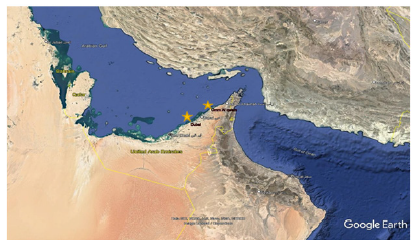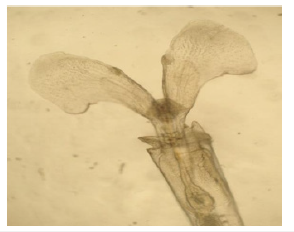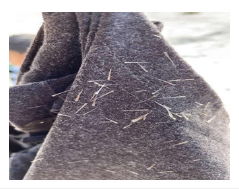- Submissions

Full Text
Biodiversity Online J
An outbreak of Pelagic Pteropod Creisis acicula (Rang, 1828) in United Arab-Emirates
Jaishinimol B*, Ebrahim Jamali, Rashid M Al Shihi and Meera H. Al Ali
Marine Environment Research Department, Ministry of Climate Change and Environment United Arab Emirates
*Corresponding author:Jaishinimol Bharghavan, Marine Environment Research Department, Ministry of Climate Change and Environment, P.O. Box 1509, Dubai, United Arab Emirates
Submission: July 21, 2022; Published: August 18, 2022

ISSN 2637-7082Volume3 Issue2
Abstract
Creseis acicula is a circumglobal holoplanktonic pelagic pteropod species, occurring worldwide in marine coastal environments. An unprecedented swarm of Creseis acicula was observed in United Arab Emirates, during May- June 2021. The initiation of the swarm was abrupt and lasted for about 2 weeks. The maximum abundance of Creseis acicula was up to 1000 No.m-3, 3 times the local record high, and 10 times the highest number recorded elsewhere. The rising occurrences of extreme weather due to global change, the possibilities of recurrent Creseis acicula blooms worldwide certainly deserve attention. This paper represents a brief report on the short lived Creseis acicula swarms observed in coastal waters of the United Arab Emirates.
Keywords:Pteropod; Creisis acicula; Arabian gulf; United Arab Emirates
Introduction
Pteropods, pelagic holoplanktonic mollusks are common members of marine zooplankton assemblages, [1]. Creseis acicula is a common pteropod species usually found in the warmer waters of all oceans in the upper water layers between 10 and 100m and migrates to the sea surface during the night [2]. As they are a major food source for other marine organisms, they play an important role in the marine food web [3]. Creseis acicula blooms have been reported earlier from world over the years. Few reports of this species blooming have been reported in the Indian Ocean were reported by [4-6]. In the Mediterranean Sea report of Creseis acicula swarm was recorded by [7,8]. Morioka [9] reported a swarm of the species in Japan Sea. The latest reports of unprecedented blooms have been reported from Daya Bay, China in 2020 [10] and Canakkale Strait in NE Aegean Sea, Turkey also in 2020 that lasted for over a month and caused economic losses [11] Creseis acicula is a common zooplankton species reported from the Arabian Gulf [12] but the swarm occurred in 2021 is the first report of any such incident from the region especially from UAE. Here we present a briefing of this unusual outbreak by summarizing our observations of the swarm and its associated environmental conditions to provide a big picture of this zooplankton bloom. This report definitely would enable further investigations and promote attention to possible recurrent aggregation of Creseis acicula and other organisms in the ocean, particularly in the context of global warming.
Materials and Methods
A sudden outbreak of dense swarms of pteropod, Creseis acicula was reported in the United Arab Emirates (UAE) to be floating in Arabian Gulf coast, namely in, Umm Al Quwain coastal waters, followed by a similar swarm in Dubai Coast after around 2 weeks. The samples were taken from the reported areas surface at a depth of 0-1m using Niskin water sampler and plankton net tow. The samples were collected into clean sample bottles and fixed in 5% formaldehyde solution and then transported to the Marine Environment Research Department laboratory for further analysis. The samples were studied qualitatively and quantitatively. Stereo microscopy was used to identify, measure individuals, and study their morphological and record images (Figure 1).
Figure 1: Map showing location of Creseis acicula swarms (Google Earth image: Accessed July20th,2022).

Result and Discussion
Species description
Table 1:

Figure 2a: Stereo dissecting microscope (0.8X magnification).

Figure 2b: Inverted phase microscope (4X magnification).

Figure 2c: Dead Creseis acicula on beach after 2 days.

Figure 2d:Shells of Creseis acicula stuck to clothes.

(Table 1) (Figure 2) Creisis acicula (Rang, 1828) a pelagic shelled pteropod (‘sea butterflies’). The average size range of Creisis acicula reported in UAE was between 4.72mm-7.34mm cm, with a transparent uncoiled long and narrow shell with smooth surface. The shell is extremely, tube-shaped, and not curved. The visceral mass can be seen through the shell. The wings have a wing protrusion and opposite a wing gland. The wing glands overlap the base of the wing protrusion. The species is phytophagous and epipelagic. Mass swarming in coastal waters during summer is a normal phenomenon in Creseis acicula. In the Mandapam Lagoon, Indian Ocean this species lives between 26°-33 °C and a salinity between 25-45°/oo. As reported in earlier studies it occurs in swarms and is sometimes abundant in neritic waters [6] at regions with temperature and salinity ranges are about 10.0°- 27.9 °C and 35.5-36.7°/oo S, respectively. During the swarm the water parameters recorded in the sampled sites were also in a similar range (Table 2). Creseis acicula, a common zooplankton species reported from the Arabian Gulf but usually with low abundance of 50 -100 No.m-3 [12]. During the present swarm the number of organisms recorded was in range of 103 Noml-1, which high than usual. Creisis swarm 372 No.m-3 has reported the in the Indian Ocean [4] that coincided with the occurrences of Trichodesmium swarm but in this case no such incident of bloom was observed. Also, a similar range was noted in Bay of Bengal during 1977; 474.8 No.m-3 [13]. The swarm that occurred in UAE is almost two times than these records, but was less than Daya bay, where a maximum abundance of 5595 No.m-3 was recorded [10] Information on prior incidences swarms of zooplankton especially Creseis species from the United Arab Emirates or from the Arabian Gulf in particular is very limited. Generally, in zooplanktons swarming behavior is affected by their interactions with light cues, water currents and turbulence, behavior of their predators and prey, and abundance of other trophic levels. The food availability could also be an essential factor for the outbreak of Creseis acicula. Factors like predation, active movement, vertical migration, or reproduction can influence the dynamics and abundance of zooplankton communities, resulting in different spatial aggregations. Such factors cause these zooplanktons to enter shallow waters where they subsequently die and wash up on the beaches. A similar scenario was noted in UAE too where a couple of days after the incident they were seen deposited on the beach sand. The food of pteropods like that of most plankton feeders is composed of phytoplankton and protozoa such as diatoms, dinoflagellates, and minute crustaceans. The reason for the sudden appearance is usually due to increase in the water temperature. It is noteworthy that in Daya Bay, coincident with the temperature increase, the concentration of Chla also increased and maintained at a relatively high level for one week, which has been attributed to high loads of and is suggested that there was a high supply of food resources for Creseis acicula which caused the bloom. In the United Arab Emirates, the chlorophyll in coastal waters s ranged between 0.2- 2mg m3 Chla (https:// oceancolor.gsfc.nasa.gov/l3/) showing no such definite trend. Similarly, in the Indian ocean then high abundance swarms were noticed between March – May, the same time of the year when the high abundance was noted in the United Arab Emirates. In the incident that occurred in the United Arab Emirates we assume that the environment conditions of were suitable or tolerable for Creseis acicula, while did not for its competitor or predator, therefore, huge number of individuals survived, and the swarm was formed. Pteropods are most likely found on upper layer of the world’s oceans and a single condition on its own could not have caused the outbreak. But it is noteworthy that swarm incidents recurred in Umm Al Quwain & Dubai in a period of 7-14 days which can be attributed to the increase in temperature, water currents and wind during that time. Creseis acicula although does not pose any threat to human life can cause reactions on people with skin allergies. No harmful effects were noted in the incidence in UAE too, but citizen reports of incidents of the shell clinging to clothes in beach goers. A sharp increase of temperature and change of currents due to winds possibly have attributed to the unprecedented bloom. These conditions combined with other unknown factors might have led to such a tremendous surge in the amount of Creseis acicula. The specific inherent mechanism triggering such an intensive swarm of Creseis acicula remains unknown due to very limited information. The possibilities of a future surge of Creseis acicula, its occurrence elsewhere, and its potential of becoming a global recurrent issue like jellyfish certainly cannot be ruled out and deserves attention. To better characterize and understand this organism, it is necessary to assess possible ecological sequences and outbreak of Creseis acicula, our studies will continue into the future. No lethal or toxic effect was noticed during both incidents except hampering the tourist to swim in the infested beaches. The phenomenon lasted for a few hours after which it disappeared, and the dead organism shells were washed ashore and deposited on the sand.
Table 2:Marine environmental parameters recorded at swarm locations.

Conclusion
This is the first detailed data of Creseis acicula Rang, swarm along the UAE coast together with measured marine environmental parameters observed during May-June 2021 in Umm Al Quwain- Dubai. The possible factors that may have favored this monospecific swarm of Creseis acicula has been interpreted. Creseis acicula being one of the most common pteropod species in the tropical and with recent reports of swarm events from different coastal habitats of the world it is important to expand our knowledge of this species. It could serve as an indicator of environmental change. Our study emphasizes the importance of data collection of Creseis acicula Rang, 1828 to investigate the effects of the interaction between climate change and anthropogenic contribution in sensitive marine ecosystem.
Acknowledgement
The authors are grateful to Ministry of Climate Change and Environment, UAE for providing funding and logistics support for this study.
References
- Peijnenburg KTCA, Janssen AW, Wall PD, Goetze E, Maas AE, et al. (2020) The origin and diversification of pteropods precede past perturbations in the earth’s carbon cycle. Proc Natl Acad Sci USA 117(41): 25609– 25617.
- Menzies RJ (1957) Shell-bearing pteropod gastropods from mediterranean (Cavoliniidae). Pubb Staz Zool Napoli 30: 381–401.
- Lalli CM, Gilmer RW (1989) Pelagic Snails: The Biology of Holoplanktonic Gastropod Mollusks. Stanford University Press, USA.
- Sakthivel M, Harida P (1974) Synchronization in the occurance of Trichodesmium bloom and swarming of Creseis Acicula rang (Pteropoda) and Penilia avirostris (Cladocera) in the area off Cochin. Mahasagar 7(1&2): 61–67.
- Krishna MK (1967) Seasonal variation in the plankton of Porto Novo waters, India. Hydrobiologia 29: 226- 238.
- Krishna PS, Xavier RJ (1984) Swarming of Cresies acicula Rang (Pteropoda) in the Palk Bay Mandapam. J Mar Bio Assoc India 21: 178-180.
- Hutton RF (1960) Marine Dermatosis. Archives of Dermatology 82(6): 951.
- Kokelj F, Milani L, Lavaroni G, Casaretto L (1994) Marine dermatitis due to Creseis acicula. J Eur Acad Dermatol Venereol 3: 555–561.
- Morioka Y (1980) Dense population of a pteropod, Creseis acicula (needle sea butterfly) in the neritic waters of the middle Japan Sea. Bull Jap Sea Reg Fish Res Lab (31): 169-171.
- Ming D, Zhanhui Q, Lei Z, Shufei Z, Lingling W (2020) An unprecedented outbreak of pelagic molluscs Creseis acicula in Daya Bay, South China Sea. Authorea pp: 1-7.
- Sezginer T, Nazik Ö, Fikret Ç, Alkan Ö, Ayhan O, et al. (2021) First record of straight needle pteropod Creseis acicula Rang, 1828 bloom in the Çanakkale Strait (NE Aegean Sea, Turkey). Oceanological and Hydrobiological Studies 50(3): 311-324
- ROPME (2013) Zooplankton in the ROPME Sea Area ROPME/GC - 14/7. Monograph Series 2: 387
- Peter KJ, Paulinose VT (1978) Swarming of Creseis acicula Rang (Pteropoda) in the Bay of Bengal. Indian J Mar Sci 7: 126-127.
© 2022 Jaishinimol B. This is an open access article distributed under the terms of the Creative Commons Attribution License , which permits unrestricted use, distribution, and build upon your work non-commercially.
 a Creative Commons Attribution 4.0 International License. Based on a work at www.crimsonpublishers.com.
Best viewed in
a Creative Commons Attribution 4.0 International License. Based on a work at www.crimsonpublishers.com.
Best viewed in 







.jpg)






























 Editorial Board Registrations
Editorial Board Registrations Submit your Article
Submit your Article Refer a Friend
Refer a Friend Advertise With Us
Advertise With Us
.jpg)






.jpg)














.bmp)
.jpg)
.png)
.jpg)










.jpg)






.png)

.png)



.png)






